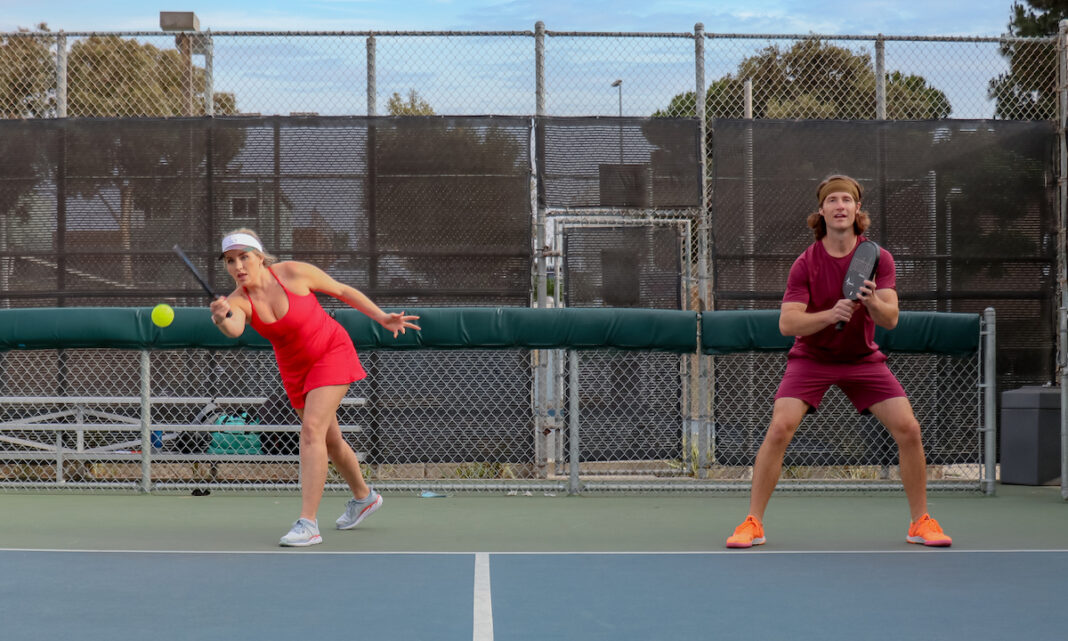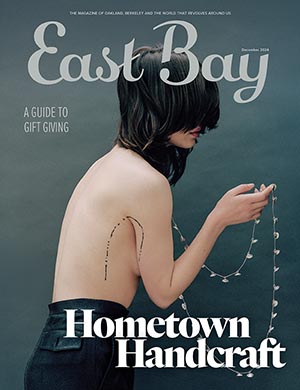By this point in the pickleball revolution, it’s the rare Bay Area resident who hasn’t played the fastest-growing sport in America, or seen big, cheerful groups of people playing it, or at least heard the telltale thwack of a pickleball paddle.
Pickleball was originally invented in 1965 by bored summer vacationers looking for a racket sport that the whole family could play together. Nearly 60 years later, the sport is unrecognizable. There are two pro pickleball tours, a professional league and an official mascot: a giant ball named Kitchen in a cap, shades and net-print shorts.
There are “In my pickleball era” T-shirts, boozy pickleball meet-ups and pickleball memes (“The first rule of pickleball is…you tell everyone about pickleball”). There’s even competing lore about the origin of the name: No one denies that one of the founding families owned a cockapoo puppy named Pickles…but was the game named after the dog, or the dog after the game?
All of these are the inevitable growing pains of a sport that has ballooned to be one of the most popular by participation in the country, at 36.6 million players. But pickleball is uniquely invested in protecting the amateur-friendly and family-oriented soul of the game.
This year, the Pickleball Association banned the “spin serve,” (during which a player uses his or her non-paddle hand to spin the pickleball before hitting a serve, creating an unpredictable bounce) because “only a limited number of players have mastered this, giving them an unfair advantage,” and “the spin serve is particularly devastating for amateur players.” Pickleball is very deliberately designed to be a sport that newcomers and pros can actually play together.
“It’s incredibly easy to learn,” says Darlene Vendegna, an official USA Pickleball ambassador, Professional Pickleball Registry-certified coach and Bay Area pickleball legend. She thinks that the inclusive, accessible quality is behind the meteoric rise of the sport. “There’s a low barrier to entry,” Vendegna explains.
The nature of the game makes it far more forgiving for new, young and elderly players than most sports. The ball is both lighter and less bouncy than a tennis ball; players don’t need much strength to hit it effectively; and overzealous beginners are less likely to overshoot and hit the ball out of the court entirely. With a court just over half the size of a tennis court, pickleball requires less sprinting, and the light paddles are easy to swing.
“People who don’t come from a ball-sport background at all, but they want to do something outside that’s fun—they flock to it,” says Vendegna.
Gameplay is relatively simple, a hybrid between tennis, ping pong and badminton. Players—in singles or doubles—hit a ball back and forth over a short net, hitting balls off a bounce (a “groundstroke”) or out of the air (a “volley”). There’s a seven-foot no-volley zone near the net, called “the kitchen,” where players must wait for the ball to bounce before hitting it. Gameplay continues until a serve does not clear the kitchen, a shot is hit out of bounds or a shot is hit into the net. Games are usually played to 11 points.
Like all sports, pickleball has its quirks and lingo (“dill ball,” “dink shot,” “getting pickled,” “the Bert” and “the Erne,” etc.), but its simple set-up and gentle learning curve get new players hooked quickly.
Vendegna was introduced to pickleball for the first time in 2016. “Within five minutes, I was completely in,” she says. “I bought a paddle the next day. The next week, I bought a net.” Now, she spreads the gospel of pickleball across the Bay Area. Her pickleball email group has grown to over 2,000 members. She closes every email with the signoff: “Pickleball to the people!”
In Vendegna’s opinion, pickleball has something for everyone—she sees everyone from tennis players who come to work on footwork with less strain to their shoulders, to racquetball players who want to move outdoors due to COVID, to bridge and mahjong players who like the social aspects of the game.
“It’s such a social game because the court is so small,” says Vendegna. “You can easily be carrying out a conversation while you’re playing. Much to the dismay of some of my partners.”
Plenty of people who are new to sport- and game-playing are coming to pickleball as a way to build community, make friends and stay active. “I’ve lost count of the people who have said to me that they just moved here and I helped them find a community, or they just retired and suddenly their dance card is completely full,” says Vendegna. “So many people I know have good friends that they met playing pickleball.”
Families have flocked to the sport as well. The game is designed to be intergenerational—and according to Vendegna, it really works. “I taught my 89-year-old mother to play, and she played with her 10-year-old great-granddaughter,” she says. “There’s no other sport where that can happen.”
Pickleball’s ease of play means that size and strength don’t make for a massive advantage, giving younger players a genuine opportunity to win. “Mom and Dad and two kids can go out and have a competitive game,” Vendegna says. “It’s not Dad playing nice with daughter; it’s daughter wailing on Dad because she’s faster.”
Kim Bistrong, 57, who has recently taken up pickleball for the first time, likes that the game feels less about competition than about intergenerational fun. “It’s not just talk,” she says. “You do get the sense that the movement and the engagement is the goal.”
Bistrong has had three lessons with Vendegna. “The first lesson was amazing,” Bistrong says. “She made me feel like I knew what I was doing.” She considered setting up a fourth lesson—but Vendegna told her she’s ready to hit the court. “She didn’t even want to take the money,” says Bistrong. “She’s like, ‘You’re ready. Just like get out there. I promise you’ll meet people at your level.’”
For East Bay residents who are curious about how to get started, local pickleball ambassadors like Vengedna are ready to proselytize. “We’re all big labrador retrievers who just want everyone to have fun and play this game,” Vendegna says.
There are about 100 pickleball courts scattered across parks and rec centers in the East Bay, and plenty of support for finding a game. Vendegna is happy for any pickleball-curious East Bayers to reach out to her at [email protected].
Vendegna estimates that about 20% of new players just show up at a meet-up and hope someone shows them the ropes. Usually, the community is happy to oblige, but Vendegna recommends taking a quick intro class to learn the rules and practice a few volleys. She and her assistant coaches host an open play at Bushrod Park in north Oakland four times per week, and use one court to give first-timers an intro clinic for 90 minutes or so. They supply balls and paddles, and ask for $10.
Vendegna’s enthusiasm is undeniably infectious. “I had a gal come up to me—in her mid-60s—and say, ‘I’ve never been athletic; I’ve never played a sport,’” Vendegna says. “Within 10 minutes, she was saying, ‘This is really fun, I want to buy a paddle.’ That’s what it’s about.”













